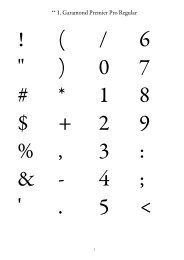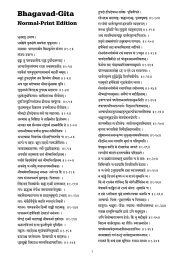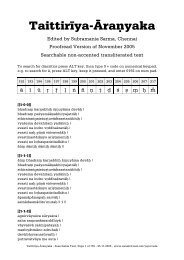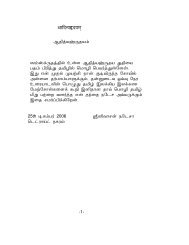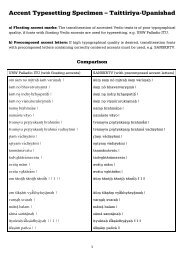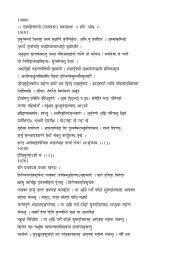[[1-1-1]] [[Book-Chapter-Paragraph]] - Sanskrit Web
[[1-1-1]] [[Book-Chapter-Paragraph]] - Sanskrit Web
[[1-1-1]] [[Book-Chapter-Paragraph]] - Sanskrit Web
You also want an ePaper? Increase the reach of your titles
YUMPU automatically turns print PDFs into web optimized ePapers that Google loves.
moon in Phalguni. The full moon in Phalguni is the beginning of the year [1]; verily they consecrate<br />
them selves grasping the year at its beginning. To that there is this one objection that the Visuvant<br />
day falls in the cloudy season. They should consecrate themselves on the full moon in Citra. The<br />
full moon in Citra, is the beginning of the year; verily they consecrate themselves grasping the year<br />
at the beginning. In that there is no objection at all. They should consecrate themselves on the<br />
fourth day before the full moon. Then the buying (of the Soma) falls for them on the Ekastaka;<br />
verily they do not waste the Ekastaka. In their case [2] the pressing-(day) falls on the first half (of<br />
the month), the months end in the first half, they complete (the rite) in the first half, and when they<br />
complete the rite the plants and trees come out after them. And after them follows the fair report,<br />
'These sacrificers have succeeded', and therefore all succeed.<br />
[[7-4-9]]<br />
They go to the world of heaven who perform the Sattra. They kindle themselves with the Diksas,<br />
and cook themselves with the Upasads. With two they cut off their hair, with two their skin, with<br />
two their blood, with two their flesh, with two their bones, with two their marrow. In the Sattra the<br />
self is the sacrificial gift; verily taking the self as the gift they go to the world of heaven. They cut<br />
off the top-knot, for prosperity, (thinking), 'More swiftly may we attain the world of heaven.'<br />
[[7-4-10]]<br />
The theologians say, 'The Atiratra is the highest of the forms of sacrifice. Why do they perform it<br />
first?' Now in doing so they really perform in order first the Agnistoma, then the Ukthya, then the<br />
Sodaçin, then the Atiratra, all the forms of sacrifice, and seizing and holding them, they keep<br />
drinking the Soma. They perform the Jyotistoma first; the Jyotistoma is the beginning of the<br />
Stomas; verily they commence the Stomas from the beginning [1]. The Stomas being sung together<br />
make up the Viraj, and two verses are redundant; the Gostoma has one too many, and the Ayustoma<br />
one too few. The Jyotistoma is the world of heaven, the Viraj is strength; verily by it they go to the<br />
world of heaven. 'The Rathantara is used in the day, the Rathantara at night', say the theologians,<br />
'what is used to avoid repetition?' The great Saman of Sobhari is used as the Brahmasaman at the<br />
third pressing; it they place in the middle, to separate them; verily there is no repetition.<br />
[[7-4-11]]<br />
They first perform the Jyotistoma; verily by it they find support in this world. They perform<br />
secondly the Gostoma; verily by it they find support in the atmosphere. They perform thirdly the<br />
Ayustoma; verily by it they find support in yonder world. The Jyotis is this (earth), the Go the<br />
atmosphere, and the Ayus yonder (sky). In that they perform these Stomas, the performers of the<br />
Sattra keep finding support in these worlds. These, (Stomas) being sung together make up the Viraj<br />
[1], and two verses are redundant; the Gostoma has one too many, and the Ayustoma one too few.<br />
The Jyotistoma is the world of heaven, the Viraj is strength; verily they win strength. They<br />
experience not misery through hunger, and are not hungry, for the performers of Sattras are as it<br />
were afflicted with hunger. The two Agnistomas on either side are the rims, the Ukthyas in the<br />
middle the nave, and that is the circling wheel of the gods. In that they go [2] by that Sadaha, they<br />
mount the wheel of the gods, for safety. They obtain prosperity. They go with the Sadaha; there are<br />
six seasons; verily in the seasons they find support. The go with a Jyotistoma on either hand; verily<br />
on either hand they find support in the world of heaven. There are two Sadahas, they make up<br />
twelve days. Man is of twelve parts, two thighs, two arms, the trunk and the head, four members,<br />
and the breasts as the eleventh and twelfth [3]. Therefore (the days) follow man. There are three<br />
Sadahas, they make up eighteen days, nine and nine. Nine are the breaths in man; verily they follow<br />
the breaths. There are four Sadahas, they make up twenty-four days. The year consists of twentyfour<br />
half-months; verily they follow the year. 'The year is not fixed', they say. 'It is greater than a<br />
support.' The Brahmana of the month is that of the year also verily they go finding support in each<br />
month.<br />
The Horse Sacrifice (continued)<br />
Keith: Taittiriya-Samhita, Translation - Page 328 of 341


![[[1-1-1]] [[Book-Chapter-Paragraph]] - Sanskrit Web](https://img.yumpu.com/25993632/328/500x640/1-1-1-book-chapter-paragraph-sanskrit-web.jpg)



